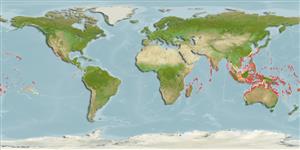Common names from other countries
>
Tetraodontiformes (Puffers and filefishes) >
Tetraodontidae (Puffers) > Canthigasterinae
Etymology: Canthigaster: Greek, kanthos = the outer or inner corner of the eye, where the lids meet, 1646 + Greek, gaster = stomach (Ref. 45335).
More on author: Bleeker.
Environment: milieu / climate zone / depth range / distribution range
पारिस्थितिकी
समुद्री प्रवाल-भित्ति संयुक्त; गहराई सीमा 1 - 30 m (Ref. 1602). Tropical; 32°N - 32°S
Indo-Pacific: East Africa south to Transkei, South Africa (Ref. 4919) and east to the Line, Marquesan, and Oeno islands, north to southern Japan, south to Lord Howe Island. Replaced by Canthigaster jactator in the Hawaiian Islands and Canthigaster punctatissimus in the tropical eastern Pacific (Ref. 37816). Also recorded from Southeast Atlantic.
आकार / वज़न / Age
Maturity: Lm ? range ? - ? cm
Max length : 9.0 cm TL पुल्लिंग / अलिंग; (Ref. 4919)
पृष्ठीय रीढ़ (सम्पूर्ण) : 0; पृष्ठीय सौफट रेज़ (सम्पूर्ण) : 9 - 10; गुदा कांटा: 0; ऐनल सौफट रेज़: 9 - 10. Many white spots scattered on body (Ref. 559).
Occurs in clear lagoon and seaward reefs, Ref. 48637. Found with sponges at various depths (Ref. 48637). Prefers sheltered areas in the form of holes in dead and living corals. Solitary or paired. Feeds on sponges, polychaetes, filamentous algae and on smaller quantities of tunicates, crustaceans, echinoderms and corals.
Life cycle and mating behavior
Maturities | पुनरुत्पत्ति | Spawnings | Egg(s) | Fecundities | लार्वा
Myers, R.F., 1991. Micronesian reef fishes. Second Ed. Coral Graphics, Barrigada, Guam. 298 p. (Ref. 1602)
IUCN Red List Status (Ref. 130435)
CITES (Ref. 128078)
Not Evaluated
Threat to humans
Harmless
Human uses
मात्स्यिकी: व्यापारिक; जलजीवालय: व्यापारिक
साधन
Special reports
Download XML
इंटरनेट स्रोत
Estimates based on models
Preferred temperature (Ref.
115969): 24.7 - 29.3, mean 28.3 (based on 2816 cells).
Phylogenetic diversity index (Ref.
82804): PD
50 = 0.5000 [Uniqueness, from 0.5 = low to 2.0 = high].
Bayesian length-weight: a=0.03631 (0.01554 - 0.08482), b=2.88 (2.69 - 3.07), in cm Total Length, based on LWR estimates for this Genus-body shape (Ref.
93245).
Trophic level (Ref.
69278): 3.1 ±0.32 se; based on food items.
लौटाव (Ref.
120179): ऊंचा, न्यूनतम जनसंख्या दुगनी समय अवलागत 15 महीने। (Preliminary K or Fecundity.).
Fishing Vulnerability (Ref.
59153): Low vulnerability (10 of 100).
